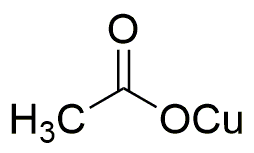Copper(I) acetate is widely utilized in research focused on:
- Catalysis: It serves as an effective catalyst in various organic reactions, enhancing reaction rates and selectivity. This is particularly beneficial in the synthesis of fine chemicals and pharmaceuticals.
- Organic Synthesis: Researchers use it in the preparation of various organic compounds, including those used in dyes and pigments, due to its ability to facilitate coupling reactions.
- Material Science: In the development of conductive polymers and nanomaterials, copper(I) acetate is employed to improve electrical properties, making it valuable in electronics and sensor applications.
- Antimicrobial Applications: Its antimicrobial properties make it useful in coatings and treatments for surfaces that require protection against bacteria and fungi, particularly in healthcare settings.
- Research in Coordination Chemistry: It is a key component in studying coordination compounds, helping researchers understand metal-ligand interactions, which is crucial for developing new materials and catalysts.
Información general
Propiedades
Seguridad y normativas
Aplicaciones
Copper(I) acetate is widely utilized in research focused on:
- Catalysis: It serves as an effective catalyst in various organic reactions, enhancing reaction rates and selectivity. This is particularly beneficial in the synthesis of fine chemicals and pharmaceuticals.
- Organic Synthesis: Researchers use it in the preparation of various organic compounds, including those used in dyes and pigments, due to its ability to facilitate coupling reactions.
- Material Science: In the development of conductive polymers and nanomaterials, copper(I) acetate is employed to improve electrical properties, making it valuable in electronics and sensor applications.
- Antimicrobial Applications: Its antimicrobial properties make it useful in coatings and treatments for surfaces that require protection against bacteria and fungi, particularly in healthcare settings.
- Research in Coordination Chemistry: It is a key component in studying coordination compounds, helping researchers understand metal-ligand interactions, which is crucial for developing new materials and catalysts.
Documentos
Hojas de datos de seguridad (HDS)
La SDS proporciona información de seguridad completa sobre la manipulación, el almacenamiento y la eliminación del producto.
Especificación del producto (PS)
La PS proporciona un desglose completo de las propiedades del producto, incluida la composición química, el estado físico, la pureza y los requisitos de almacenamiento. También detalla los rangos de calidad aceptables y las aplicaciones previstas del producto.
Certificados de análisis (COA)
Busque certificados de análisis (COA) ingresando el número de lote del producto. Los números de lote y de partida se pueden encontrar en la etiqueta de un producto después de las palabras "Lote" o "Lote".
Número de catálogo
Número de lote/lote
Certificados de origen (COO)
Este certificado de origen confirma el país en el que se fabricó el producto y también detalla los materiales y componentes utilizados en él y si se deriva de fuentes naturales, sintéticas u otras fuentes específicas. Este certificado puede ser necesario para cumplir con las normativas aduaneras, comerciales y regulatorias.
Número de catálogo
Número de lote/lote
Hojas de datos de seguridad (HDS)
La SDS proporciona información de seguridad completa sobre la manipulación, el almacenamiento y la eliminación del producto.
DownloadEspecificación del producto (PS)
La PS proporciona un desglose completo de las propiedades del producto, incluida la composición química, el estado físico, la pureza y los requisitos de almacenamiento. También detalla los rangos de calidad aceptables y las aplicaciones previstas del producto.
DownloadCertificados de análisis (COA)
Busque certificados de análisis (COA) ingresando el número de lote del producto. Los números de lote y de partida se pueden encontrar en la etiqueta de un producto después de las palabras "Lote" o "Lote".
Número de catálogo
Número de lote/lote
Certificados de origen (COO)
Este certificado de origen confirma el país en el que se fabricó el producto y también detalla los materiales y componentes utilizados en él y si se deriva de fuentes naturales, sintéticas u otras fuentes específicas. Este certificado puede ser necesario para cumplir con las normativas aduaneras, comerciales y regulatorias.


